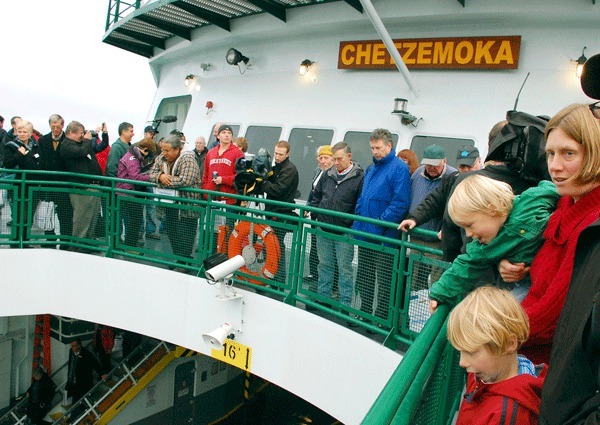After three long years, the wait is finally over.
The 64-car ferry Chetzemoka began regular service on the Coupeville-to-Port Townsend ferry route Monday following its inaugural sail and christening by Gov. Chris Gregoire Sunday, Nov. 14.
Under a constant drizzle, hundreds of dignitaries, from local and state officials to merchants and business leaders, turned out to witness the historic event that took place on both sides of Admiralty Inlet.
Although the excitement of the event was palpable with smiles everywhere you looked, like the weather, the ceremonies welcoming the vessel to the route were overcast by a pall of uncertainty. From the homemade buttons on people’s rain coats that read “Restore ferry route capacity, Chetzemoka 2010 and Salish 2011,” to the varied messages from the state’s most powerful elected officials, it seemed no one could talk about the new ferry without also talking about the fate of the Salish, the second of three boats in the class being built.
Responding to Gregoire’s request to come up with budget cuts, Washington State Ferries has proposed an option that would result in the second boat, which was promised for summer service on the Coupeville-to-Port Townsend ferry route, being sent to the San Juan Islands instead.
Speaking from a podium on the car deck just minutes after Gregoire christened the Chetzemoka by breaking a bottle of champagne over one of its rails at the Coupeville Terminal, Sen. Mary Margaret Haugen (D-Camano Island), chair of the Senate Transportation Committee, made it clear that she not only supports restoring the route to the same level of service enjoyed under the old Steel Electric ferries, but fully expects that to be the outcome.
“This is Whidbey’s boat, one of two,” Haugen said.
The governor made no such promise. In the face of recent and highly publicized criticisms over the boat’s cost, at least $76.5 million, Gregoire’s comments focused on the qualities of the Chetzemoka and the state’s response to the ferry crisis. Crediting elected officials, from Haugen and other state legislators to mayors Nancy Conard and Michelle Sandoval, she thanked them for making the boat a reality and not settling for smaller vessels that could have been built faster.
“We heard, we responded, we did what you asked for; you got the best and congratulations to all of you,” she said.
“She is stout as a ship, she is sound, she will sail the toughest route in our entire ferry system,” Gregoire said.
She did talk about the second and third boats being constructed, saying that they were on schedule and under budget. She did not voice support or opposition to the possibility of sending the Salish to another route.
The prospect continues to weigh heavily on Whidbey Island merchants, however. While sitting at one of the brand new tables on the Chetzemoka’s passenger deck, Windjammer Gallery owner Sandy Poust said she was relieved the new ferry is finally here as the impact to businesses over the past three years is still fresh in her mind.
“It made a big difference when the (Steel Electrics) left,” Poust said.
But getting a second boat on the run during the summer will just be restoring service to what it was in 2007, she said. The second boat is a key piece in restoring healthy commerce between Whidbey Island and the Olympic Peninsula.
Karen Whelan, former owner of Kapaws Iskreme on Front Street, agreed that the second boat is needed, and people shouldn’t be fooled into thinking that it’s only important for Coupeville business.
“It’s important for the whole island,” Whelan said.
Oak Harbor Mayor Jim Slowik, who said he was among a group of merchants that traveled to Olympia in recent years to lobby for service restoration and mitigation funds, said he believed the second boat and the increased tourism it could provide will undoubtedly play a role in North Whidbey’s economy. It will be particularly important to the success of city projects, such as the SE Pioneer Way improvement project.
“This is a key element in that,” Slowik said.
“Whidbey Island is to Washington what Cape Cod is to Massachusetts,” he said.
Despite the concerns, Sunday’s ceremonies seemed to be enjoyed by all. Following the christening at the Coupeville terminal, the approximately 300 invited guests took an hour ferry ride to Port Townsend enjoying onboard entertainment ranging from live music by the Shifty Sailors to tours of the vessel.
Upon its arrival, the 273-foot ferry was blessed by tribal representatives from the S’Klallam community and by relatives of Chief Chetzemoka, the 19th century Native American the vessel was named after. Among them was Les Prince, a retired Navy chief once stationed at Whidbey Island Naval Air Station and Chetzemoka’s great, great grandson.
“I truly believe, that if the old chief, who is buried a short distance from here, were standing here in my shoes today, he would raise his arms and say to you in the S’Klallam language, ‘Hot-nun-sen, hot-nun-sen,’ – thank you, thank you,” Prince said.
As the festivities wound to a close around 2 p.m. and Whidbey Island representatives boarded the Steilacoom II for the last time – the 50-car ferry leased from Pierce County – thoughts were once again turned to the Salish and the coming legislative session where its fate will ultimately be decided.
District 10 State Rep. Barbara Bailey said the Chetzemoka should serve Whidbey Island and Port Townsend well, but skimping on a second boat during the summer is “shortsighted” at best. While the high cost of building the first ferry will no doubt bring up old conversations, such as ferry funding and building boats out of state, sending the Salish somewhere else is not an option.
“That’s what we’ve been promised and what we’ve been working for at the legislature,” Bailey said.



